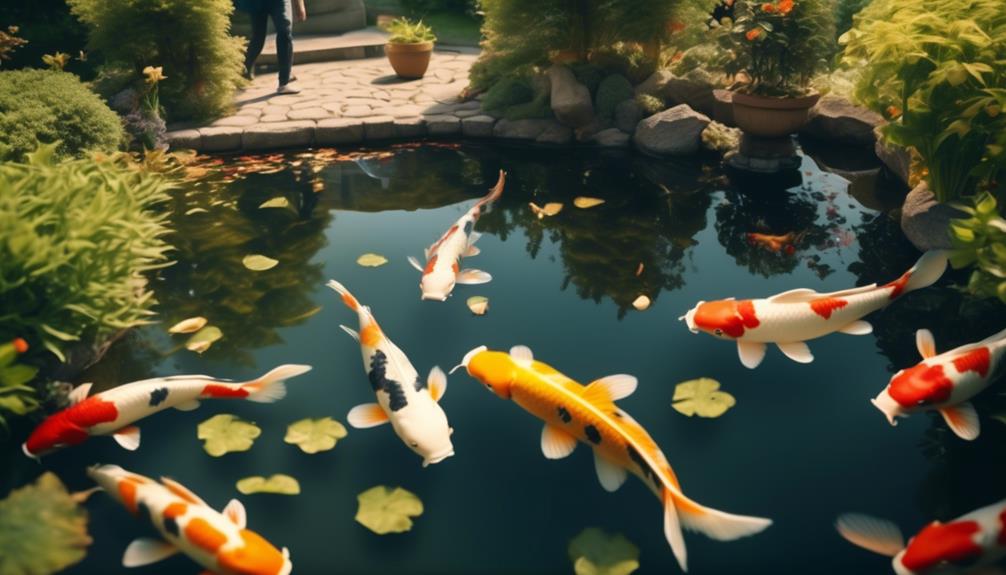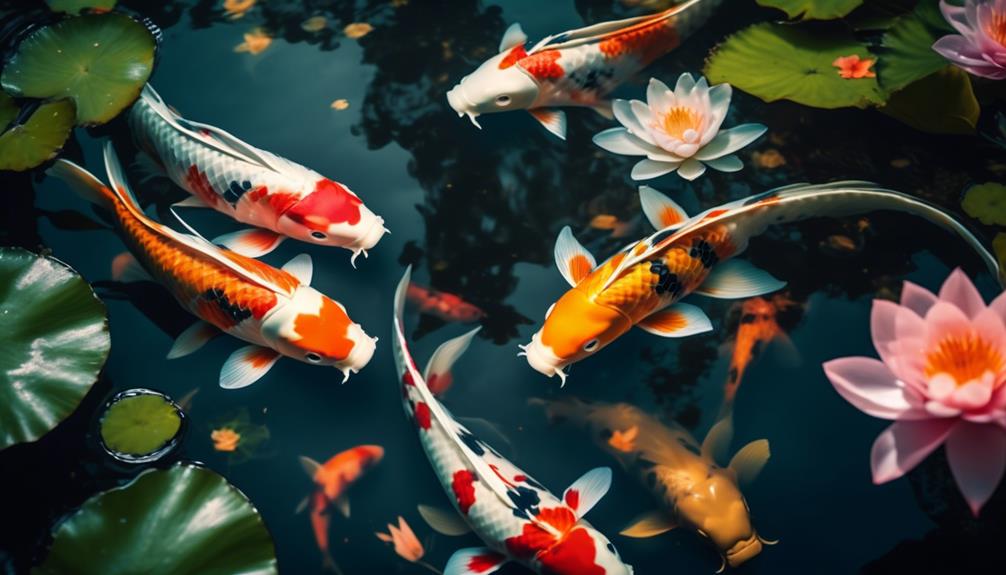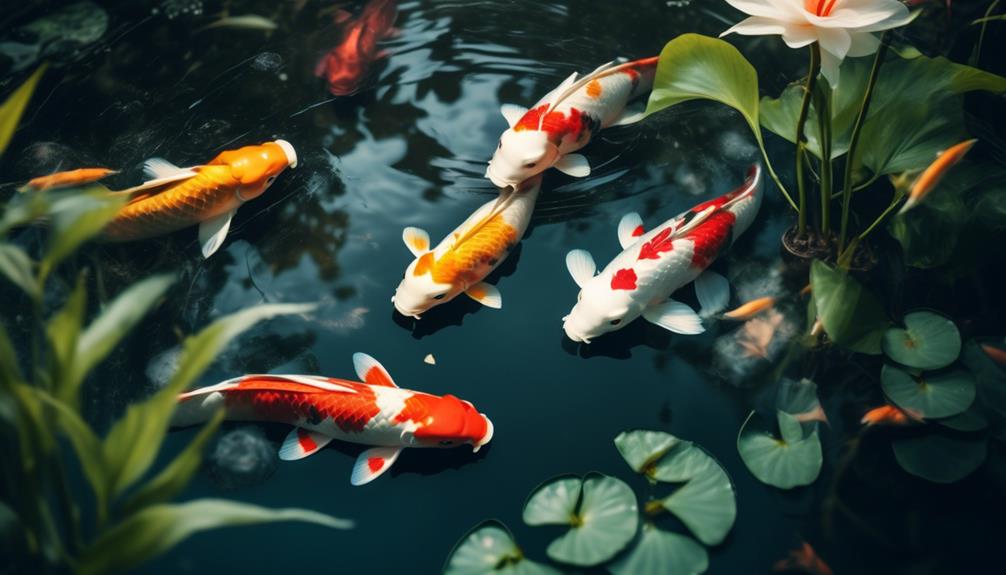As the days get longer and we welcome the start of spring, it's the perfect time to give your koi pond some extra attention. Making sure your koi are healthy and your pond is in tip-top shape requires a few important steps.
First, keep an eye on the water temperature; as it rises, your koi will become more active and need more food. Start feeding them a diet that matches their increased energy needs.
A good spring clean of your pond is also crucial. Take the time to remove any debris and waste that might have built up over winter. This not only keeps the water clean and reduces disease risk but also ensures your koi have a great environment to thrive in.
Regularly checking your pond and being ready to act quickly can prevent problems before they start. By keeping up with these spring care essentials, you're not just looking after the koi's health—you're also keeping your pond looking beautiful and balanced.
Remember to use products like a reliable water thermometer to monitor temperature changes, and consider high-quality, season-specific koi food to support their dietary needs. A clean and well-maintained pond is a happy home for your koi, and it makes for a stunning backyard feature, too.
Key Takeaways
Caring for koi fish as spring arrives involves a few important practices. It's crucial to monitor the pond's temperature since it can fluctuate. As water warms, it holds less oxygen, and koi need plenty of oxygen to thrive. So, make sure to adjust your pond heaters or coolers to maintain the right temperature.
Feeding your koi the correct amount is essential. Too much food can dirty the water, while too little can weaken your fish. Regularly cleaning the pond to get rid of waste and leaves will help keep disease at bay.
It's also beneficial to add starter bacteria to your pond. These bacteria play a vital role in breaking down fish waste and keeping the pond water clean. Keep an eye on your koi's behavior for signs of health; unusual behavior could indicate a problem with the water. Regularly test the water for pH, ammonia, nitrite, and nitrate levels to ensure it's safe for your fish.
If koi care becomes complex, don't hesitate to contact a specialist. They have the expertise to address difficult issues and help maintain your koi's health.
By keeping these points in mind, you'll be able to enjoy the vibrant colors and peaceful presence of your koi throughout the spring season.
Assessing Pond Temperature
Measuring the pond temperature accurately is key for knowing when to feed koi in the spring. Koi are cold-blooded, so the water temperature affects how their bodies work. You need a good pond thermometer to keep an eye on the water temperature. You shouldn't feed the fish until the water stays at 50 degrees Fahrenheit. When it's this warm, koi's bodies start to work faster, and they need food. But you have to be careful not to feed them too much. Start with a low-protein food that's made for cold water. This way, you won't upset their stomachs and they'll stay healthy as the seasons change.
For example, if you're looking for a thermometer, the 'AquaPlumb Floating Pond Thermometer' is a popular choice among koi enthusiasts. It's easy to read and will help ensure you're feeding your koi at the right time. Remember, start feeding slowly once the water is warm enough, and watch your koi thrive as they get ready for more active months ahead.
Spring Feeding Guidelines
As spring arrives and the pond water gets warmer, it's important to feed your koi fish correctly. They have been less active in the cold, so their feeding needs change. Here's a simple guide for what to do at different temperatures:
- When it's below 50°F, don't feed your koi because their bodies are still in slow mode.
- Between 50°F and 55°F, feed them every two or three days with food made from wheat germ.
- As the water gets warmer, between 55°F and 59°F, you can start feeding them every day, but keep using the wheat germ food.
- Once it's over 60°F, you can slowly start giving them their usual food. Keep an eye on the pond and how your fish are doing.
- When the temperature is consistently above 65°F, go back to your regular feeding schedule.
Start with food that's easy for your koi to digest. Watch how active they are and what's happening in the pond. Change their diet and how often you feed them as it gets warmer. This helps your koi move smoothly into the warmer months.
For example, you might start with a wheat germ-based koi food like Hikari Wheat-Germ which is easy on their system. This approach is not only better for your fish, but also helps maintain a clean and healthy pond environment.
Initiating Pond Cleanout

Cleaning your pond in early spring is very important for the health of your koi fish. When it gets warmer, the waste that built up during winter can become harmful and make the water dangerous for your fish.
Start by removing all the mud, leaves, and other waste from the bottom of the pond. Make sure to thoroughly clean the rocks and any gravel by power washing them to get rid of any dirt stuck to them.
It's also important to give your filter system a good clean or change the filter materials if needed, so it works well.
After cleaning, it's a good idea to add some Pond Starter Bacteria to help good microbes grow in the water again.
If you're not sure how to do all of this, you might want to hire a professional, like a Certified Aquascape Contractor, to help you. This step is key to keeping your pond and fish in good shape.
Introducing Starter Bacteria
After you've cleaned your pond, it's important to add Starter Bacteria to make the water safe and healthy again. These good bacteria help by starting the Nitrogen Cycle. They change fish waste, which can be harmful, into safer chemicals. This process is vital because it cleans the water and keeps the pond's ecosystem in good shape.
Another benefit of adding Starter Bacteria is that it improves water clarity. The bacteria help stop algae from growing too much by using up the nutrients algae need. They also break down leftover bits of plants and animals, which makes the water less cloudy and more inviting.
In addition, Starter Bacteria help fish stay healthy. By keeping the water clean, these bacteria create a stable home for fish like koi. This helps them to stay stress-free and reduces the risk of sickness that can happen when water is dirty.
Make sure to choose a good-quality Starter Bacteria product and use it just like the label says for the best outcome.
When you do this, your pond will not only look better, but it will also be a healthier place for everything living in it.
Monitoring Koi Behavior

Spring is a vital time to watch koi fish behavior for signs of health or problems in their pond environment. Paying attention to changes in how the koi act can tell pond owners a lot about their fish's health. For example, when the water warms up, healthy koi should be moving around a lot and excited to eat. If they seem tired, swim strangely, or don't want to eat, these could be warnings of trouble. Keeping a careful watch on how the koi behave is important for a healthy pond.
Here are some specific behaviors to look out for and what they might mean:
- If koi come to the surface more than usual, they may not have enough oxygen in the water.
- Koi with fins close to their body might be stressed or sick.
- When koi keep rubbing against things in the pond, they might have parasites.
- A koi that stays away from its friends could be sick or upset.
By understanding these signs, pond owners can act quickly to fix any problems. For example, if you notice increased surface activity, you might need to add an aerator to the pond to increase oxygen levels. Should you see your koi rubbing against objects, it's wise to check for parasites with a microscope and treat the water with a recommended anti-parasitic medication. Isolation or clamped fins could warrant a water quality test and possibly a consultation with a vet who specializes in fish.
Conducting Water Tests
Monitoring koi fish behavior is a good indicator of their health, and it's just as important to regularly check the water quality of your pond, especially in spring. Keeping the water balanced helps the koi thrive. Since water conditions change with the seasons, it's crucial to stay vigilant during springtime.
- Testing Schedule
- Test for ammonia, nitrite, and pH once a week.
- Check nitrate and alkalinity levels every month.
- Evaluate the overall water hardness each season.
- Key Water Quality Levels
- Aim for zero ppm of ammonia and nitrite.
- Keep pH stable, ideally between 7.0 and 8.6.
- Maintain alkalinity over 100 ppm to prevent sudden pH changes.
- How to Test the Water
- Choose test kits that are known for accuracy.
- Keep a log of your results to spot any shifts.
- If the tests show issues, tweak your pond care to fix them.
To keep your pond's ecosystem in top shape, use test kits from trusted brands like API or Tetra. These kits should be calibrated correctly for accurate readings. By jotting down the results, you can notice trends and address problems early. If you find that the pH level is too low, for instance, you might add a pH buffer to correct it. By staying on top of water testing, you'll create a stable home for your koi to flourish.
Seeking Professional Help

When you face tough problems with your pond or you're worried about how your koi fish are doing, it's a good idea to get help from an expert. For example, Certified Aquascape Contractors have special training to take care of koi ponds. They know how to figure out and fix different problems, like if the water isn't right or if the koi seem sick. They use the latest tools and ways of doing things to make sure they solve problems well and quickly.
Plus, they can give you specific tips on how to keep your pond in good shape and stop problems before they start, which keeps your koi fish healthy. By working with these experts, you not only sort out the immediate issues but also learn helpful things for making your pond a great place for your fish to live.
For instance, if your pond water is cloudy, an expert might recommend a particular filter system to clear it up. Or, if your koi are acting strange, they could suggest testing the water for ammonia levels and then using a specific water treatment to balance things out. This way, you're not just guessing what to do; you're making informed decisions based on professional advice.
It's like having a pond coach who guides you through each step, ensuring your aquatic pets and their home are the best they can be.
Frequently Asked Questions
How Can I Safely Transition My Koi From Winter Dormancy to Active Feeding Without Causing Them Stress?
To help your koi wake up from their winter sleep safely, start feeding them again when the water is at least 50 degrees Fahrenheit. Give them food that's low in protein and don't feed them too much because their digestion is still slow after the cold months. This is important because if you feed them too much or the wrong kind of food, it can be hard on their bodies and make them sick. For example, you could start with a wheat germ-based koi food, which is easier for them to digest. Make sure to do this gradually; it's like giving them a gentle nudge rather than a sudden push back into their routine. This way, you'll see them swimming actively and staying healthy as the seasons change.
Are There Any Specific Landscaping or Shading Techniques I Can Employ to Help Regulate Pond Temperature in the Spring?
If you want to keep your pond at a stable temperature during spring, think about using some simple landscaping methods. Planting trees that lose their leaves in winter, like maples or oaks, can give your pond shade in the warmer months without blocking the sun when it's cooler. You could also put up a shade cloth or awning to block direct sunlight. Another good idea is to add water lilies or duckweed to the surface of your pond. These floating plants not only keep the water cool but also provide a home for fish and other wildlife. This shading helps because it stops the water from getting too warm, which can harm the creatures living in your pond. By using these techniques, you encourage a healthy pond ecosystem.
What Are the Best Practices for Acclimating New Koi to My Pond in the Spring?
When you're ready to add new koi to your pond in the spring, take your time to help them adjust to the water temperature. Do this slowly, over a few hours, to avoid shocking them. It's important to keep the stress for the fish to a minimum, so handle them gently and carefully. Before adding new fish, clean your pond and make sure the water quality is good after winter. This is crucial because a clean environment helps prevent sickness in your koi.
For example, you might start by floating the bag with the koi in your pond for about 15 minutes to equalize the bag's water temperature to your pond's. After that, you can add a bit of pond water to the bag every few minutes. This gradual mixing lets your koi get used to the water in their new home without stress.
When cleaning your pond, remove any debris and check the filters and pumps to ensure they're working correctly. It's also a good idea to test the water for pH, ammonia, nitrite, and nitrate levels. Products like water conditioners or test kits can be helpful for this.
Can Springtime Temperature Fluctuations Affect the Ph Balance of My Pond, and How Do I Mitigate This?
Changes in springtime temperatures can affect your pond's pH level, which is basically a measure of how acidic or basic the water is. It's important to keep an eye on this because a stable pH is crucial for the health of fish and plants in the pond. To do this, you should test the water's pH regularly. If you see any changes, you can use products designed for ponds to adjust the pH slowly, so you don't shock the ecosystem. For example, if the pH is too high, you can add a pond pH decreaser, and if it's too low, you can use a pH increaser. Remember, always follow the instructions carefully and make changes bit by bit. This way, you can create a healthy environment for your pond dwellers throughout the unpredictable spring weather.
How Do I Manage the Growth of Algae in My Pond During the Spring, Especially as I Begin to Feed My Koi More Regularly?
To keep algae under control in your pond during spring, it's important to feed your koi just the right amount of food. Too much can lead to excess nutrients, which algae love. Make sure to clean your pond often to remove any debris and waste. Introducing plants like water lilies can help too, because they use up the nutrients that algae would otherwise feed on. Keep an eye on water quality with regular testing. This way, you'll know exactly what your pond needs.
Here's a tip: Use a pond vacuum to keep the bottom clean, and consider a UV clarifier to zap algae. Remember, consistency is key, so stick to a maintenance schedule.
Conclusion
Taking care of koi fish in the spring requires careful steps. It's important to keep an eye on the pond temperature, as it can change quickly. Warm water can hold less oxygen, which koi need to stay healthy, so adjusting heaters or coolers as needed is key.
Feeding the koi the right amount of food is also crucial. Overfeeding can pollute the water, while underfeeding can weaken the fish. Clean the pond regularly to remove waste and debris, which helps prevent diseases.
Adding starter bacteria to the pond is another essential step. These bacteria help break down fish waste and keep the water clean. Watching the koi's behavior is a good way to check their health. If they seem off, it might mean the water isn't right, so test it often. Checking pH levels, ammonia, nitrite, and nitrate levels are all important.
Sometimes, koi care can get tricky. When it does, it's a good idea to call in experts. They have the knowledge to solve complex problems and keep koi healthy.
By following these tips, you can enjoy the beauty of your koi fish all through the spring.

